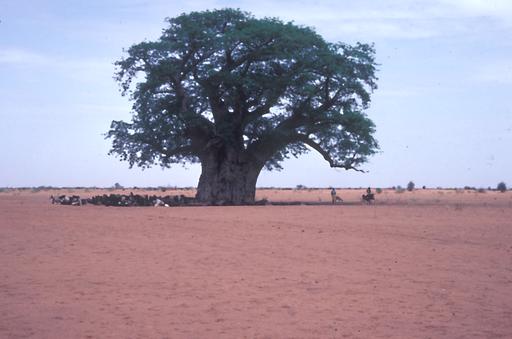Course Structure

This baobab tree in western Sudan can store water in its massive, corky, fire resistant trunk. Although soils might be fertile here, water limits agricultural production in many regions of the world. Photograph was included on the cover of Soils, Society, and the Environment, American Geological Institute, 2005. Photographer: T. Loynachan Iowa State University. Source: Earth Science World Image Bank.
This course investigates the interrelationships between geology, hydrology, land use and human development in several areas of Africa. We will focus primarily on regions north of the equator, although there is a brief segment on South African mining. Specific topics include the Nile River (sources of the Nile, agricultural practices, effects of damming the Nile, and hydropolitics), the Sahara and Sahel (salt mines, climate change, drought, and wather resources), and natural resources and their role in politics (gold, diamonds, oil, and gas). The theme of climate change cuts across the entire semester. The quantitative and analytical components of the course involve working through a combination of map exercises and data manipulations (flood stage, groundwater age, rainfall, and temperature records). Readings for the course come from the popular scientific literature, current refereed journals, and transcribed oral histories of African people.
EARTH 105 consists of 12 lessons of study, completed at a rate of one lesson per week.
- Lesson 1: Africa in Context
- Lesson 2: Africa Geologic History and Paleontology
- Lesson 3: African Biodiversity and Conservation
- Lesson 4: The Nile River - An Overview
- Lesson 5: The Nile River - Finding the Source
- Lesson 6: The Nile River - Where Does the Water Go?
- Lesson 7: Climates of Africa - Forming of the Sahara Desert
- Lesson 8: Climates of Africa - Egyptian Civilization and the Nile
- Lesson 9: Climates of Africa - Saharan Climate
- Lesson 10: East African Rifting
- Lesson 11: Natural Resources
- Lesson 12: Miscellaneous Cool Topics
The lessons in this course consist of online "lecture" materials that are rich with images and multimedia objects like video clips. Every lesson includes at least one assignment and one discussion forum posting. These activities count toward your course grade, so you will want to be sure to do them!
The first page of each lesson contains an overview of what that lesson will cover, including a list of any "external" reading assignments (articles, book chapters, etc.) and a list of "deliverables" (things you have to submit for that lesson).
In order to keep everyone going at the same pace in this course, lessons are presented one at a time, with a new lesson appearing under the Lessons tab in ANGEL each Saturday. When you see a new lesson appear, that is your cue to get started for the new week!